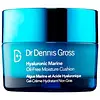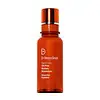What's inside
What's inside
 Key Ingredients
Key Ingredients

 Benefits
Benefits

 Concerns
Concerns

 Ingredients Side-by-side
Ingredients Side-by-side

Water
Skin ConditioningCetearyl Alcohol
EmollientC13-16 Isoparaffin
SolventStearyl Dimethicone
EmollientDimethicone
EmollientButylene Glycol
HumectantCaprylic/Capric Triglyceride
MaskingGlyceryl Behenate
EmollientSodium Hyaluronate
HumectantCaulerpa Lentillifera Extract
Saccharide Isomerate
HumectantAloe Barbadensis Leaf Extract
EmollientTocopherol
AntioxidantCitrullus Lanatus Fruit Extract
Skin ConditioningCocos Nucifera Fruit Extract
EmollientCitrus Sinensis Fruit Extract
AntioxidantVaccinium Myrtillus Fruit/Leaf Extract
AstringentLactic Acid
BufferingGlycolic Acid
BufferingSaccharum Officinarum Extract
MoisturisingLeuconostoc/Radish Root Ferment Filtrate
AntimicrobialCitrus Aurantium Dulcis Fruit Extract
MaskingCitrus Limon Fruit Extract
MaskingAcer Saccharum Extract
Skin ConditioningCollagen Amino Acids
MoisturisingAdenosine
Skin ConditioningHydrolyzed Soy Protein
HumectantCopper PCA
HumectantIsohexadecane
EmollientHeptyl Undecylenate
EmollientEthylhexylglycerin
Skin ConditioningDimethicone Crosspolymer-3
Skin ConditioningIsododecane
EmollientOctadecene
SolventSodium Acrylate/Sodium Acryloyldimethyl Taurate Copolymer
Emulsion StabilisingPotassium Cetyl Phosphate
EmulsifyingSorbitan Oleate
EmulsifyingCeteareth-20
CleansingPolysorbate 80
EmulsifyingSodium Citrate
BufferingCitric Acid
BufferingBenzyl Alcohol
PerfumingPhenoxyethanol
PreservativeSodium Benzoate
MaskingPotassium Sorbate
PreservativeWater, Cetearyl Alcohol, C13-16 Isoparaffin, Stearyl Dimethicone, Dimethicone, Butylene Glycol, Caprylic/Capric Triglyceride, Glyceryl Behenate, Sodium Hyaluronate, Caulerpa Lentillifera Extract, Saccharide Isomerate, Aloe Barbadensis Leaf Extract, Tocopherol, Citrullus Lanatus Fruit Extract, Cocos Nucifera Fruit Extract, Citrus Sinensis Fruit Extract, Vaccinium Myrtillus Fruit/Leaf Extract, Lactic Acid, Glycolic Acid, Saccharum Officinarum Extract, Leuconostoc/Radish Root Ferment Filtrate, Citrus Aurantium Dulcis Fruit Extract, Citrus Limon Fruit Extract, Acer Saccharum Extract, Collagen Amino Acids, Adenosine, Hydrolyzed Soy Protein, Copper PCA, Isohexadecane, Heptyl Undecylenate, Ethylhexylglycerin, Dimethicone Crosspolymer-3, Isododecane, Octadecene, Sodium Acrylate/Sodium Acryloyldimethyl Taurate Copolymer, Potassium Cetyl Phosphate, Sorbitan Oleate, Ceteareth-20, Polysorbate 80, Sodium Citrate, Citric Acid, Benzyl Alcohol, Phenoxyethanol, Sodium Benzoate, Potassium Sorbate
Water
Skin ConditioningSqualane
EmollientGlycerin
Humectant3-O-Ethyl Ascorbic Acid
Skin ConditioningTetrahexyldecyl Ascorbate
AntioxidantAscorbic Acid
AntioxidantLactic Acid
BufferingSilybum Marianum Fruit Extract
Skin ConditioningNiacinamide
SmoothingCentella Asiatica Extract
CleansingCeramide Ng
Skin ConditioningSuperoxide Dismutase
AntioxidantQuercetin
AntioxidantPhospholipids
Skin ConditioningSodium Hyaluronate
HumectantHydrolyzed Sodium Hyaluronate
Skin ConditioningSodium Carboxymethyl Beta-Glucan
CleansingInonotus Obliquus Extract
Skin ConditioningSaccharide Isomerate
HumectantFerulic Acid
AntimicrobialUbiquinone
AntioxidantSoy Isoflavones
Skin ConditioningAloe Barbadensis Leaf Juice
Skin ConditioningPhytosphingosine
Skin ConditioningLeuconostoc/Radish Root Ferment Filtrate
AntimicrobialMethyl Gluceth-20
HumectantPropylene Glycol
HumectantSodium PCA
HumectantMyristyl Myristate
EmollientButylene Glycol
HumectantPolyglyceryl-10 Laurate
Skin ConditioningPentylene Glycol
Skin ConditioningCaprylyl Glycol
EmollientAdenosine
Skin ConditioningCarbomer
Emulsion StabilisingCetearyl Olivate
Polyacrylate Crosspolymer-6
Emulsion StabilisingLauryl Laurate
Skin ConditioningSodium Hydroxide
BufferingPotassium Hydroxide
BufferingSodium Glycolate
BufferingC13-15 Alkane
SolventSorbitan Olivate
EmulsifyingPhytic Acid
Citric Acid
BufferingSodium Citrate
BufferingTetrasodium Glutamate Diacetate
Pentasodium Pentetate
Camellia Sinensis Leaf Extract
AntimicrobialCucumis Sativus Fruit Extract
EmollientTriethyl Citrate
MaskingLavandula Angustifolia Flower/Leaf/Stem Extract
MaskingElettaria Cardamomum Seed Extract
PerfumingPyrus Malus Fruit Extract
Skin ConditioningRubus Idaeus Fruit Extract
AstringentCananga Odorata Flower Extract
PerfumingCitrus Aurantium Bergamia Fruit Extract
Skin ConditioningCitrus Aurantium Amara Flower Extract
RefreshingCoffea Arabica Seed Extract
MaskingCucumis Melo Fruit Extract
Skin ConditioningCupressus Sempervirens Leaf/Stem Extract
Skin ConditioningFucus Vesiculosus Extract
EmollientJasminum Officinale Flower Extract
MaskingRose Extract
Skin ConditioningRosmarinus Officinalis Leaf Extract
AntimicrobialSalvia Officinalis Leaf Extract
CleansingSantalum Album Wood Extract
PerfumingPhenoxyethanol
PreservativeSorbic Acid
PreservativePotassium Sorbate
PreservativeWater, Squalane, Glycerin, 3-O-Ethyl Ascorbic Acid, Tetrahexyldecyl Ascorbate, Ascorbic Acid, Lactic Acid, Silybum Marianum Fruit Extract, Niacinamide, Centella Asiatica Extract, Ceramide Ng, Superoxide Dismutase, Quercetin, Phospholipids, Sodium Hyaluronate, Hydrolyzed Sodium Hyaluronate, Sodium Carboxymethyl Beta-Glucan, Inonotus Obliquus Extract, Saccharide Isomerate, Ferulic Acid, Ubiquinone, Soy Isoflavones, Aloe Barbadensis Leaf Juice, Phytosphingosine, Leuconostoc/Radish Root Ferment Filtrate, Methyl Gluceth-20, Propylene Glycol, Sodium PCA, Myristyl Myristate, Butylene Glycol, Polyglyceryl-10 Laurate, Pentylene Glycol, Caprylyl Glycol, Adenosine, Carbomer, Cetearyl Olivate, Polyacrylate Crosspolymer-6, Lauryl Laurate, Sodium Hydroxide, Potassium Hydroxide, Sodium Glycolate, C13-15 Alkane, Sorbitan Olivate, Phytic Acid, Citric Acid, Sodium Citrate, Tetrasodium Glutamate Diacetate, Pentasodium Pentetate, Camellia Sinensis Leaf Extract, Cucumis Sativus Fruit Extract, Triethyl Citrate, Lavandula Angustifolia Flower/Leaf/Stem Extract, Elettaria Cardamomum Seed Extract, Pyrus Malus Fruit Extract, Rubus Idaeus Fruit Extract, Cananga Odorata Flower Extract, Citrus Aurantium Bergamia Fruit Extract, Citrus Aurantium Amara Flower Extract, Coffea Arabica Seed Extract, Cucumis Melo Fruit Extract, Cupressus Sempervirens Leaf/Stem Extract, Fucus Vesiculosus Extract, Jasminum Officinale Flower Extract, Rose Extract, Rosmarinus Officinalis Leaf Extract, Salvia Officinalis Leaf Extract, Santalum Album Wood Extract, Phenoxyethanol, Sorbic Acid, Potassium Sorbate
Ingredients Explained
These ingredients are found in both products.
Ingredients higher up in an ingredient list are typically present in a larger amount.
Adenosine is in every living organism. It is one of four components in nucleic acids that helps store our DNA.
Adenosine has many benefits when used. These benefits include hydrating the skin, smoothing skin, and reducing wrinkles. Once applied, adenosine increases collagen production. It also helps with improving firmness and tissue repair.
Studies have found adenosine may also help with wound healing.
In skincare products, Adenosine is usually derived from yeast.
Learn more about AdenosineButylene Glycol (or BG) is used within cosmetic products for a few different reasons:
Overall, Butylene Glycol is a safe and well-rounded ingredient that works well with other ingredients.
Though this ingredient works well with most skin types, some people with sensitive skin may experience a reaction such as allergic rashes, closed comedones, or itchiness.
Learn more about Butylene GlycolCitric Acid is an alpha hydroxy acid (AHA) naturally found in citrus fruits like oranges, lemons, and limes.
Like other AHAs, citric acid can exfoliate skin by breaking down the bonds that hold dead skin cells together. This helps reveal smoother and brighter skin underneath.
However, this exfoliating effect only happens at high concentrations (20%) which can be hard to find in cosmetic products.
Due to this, citric acid is usually included in small amounts as a pH adjuster. This helps keep products slightly more acidic and compatible with skin's natural pH.
In skincare formulas, citric acid can:
While it can provide some skin benefits, research shows lactic acid and glycolic acid are generally more effective and less irritating exfoliants.
Most citric acid used in skincare today is made by fermenting sugars (usually from molasses). This synthetic version is identical to the natural citrus form but easier to stabilize and use in formulations.
Read more about some other popular AHA's here:
Learn more about Citric AcidLactic Acid is another well-loved alpha hydroxy acid (AHA). It is gentler than glycolic acid but still highly effective.
Its main role is to exfoliate the surface of the skin by loosening the “glue” that holds dead skin cells together. Shedding those old cells leads to smoother, softer, and more even-toned skin.
Because lactic acid molecules are larger than glycolic acid, they don’t penetrate as deeply. This means they’re less likely to sting or irritate, making it a great choice for beginners or those with sensitive skin.
Like glycolic acid, it can:
Lactic acid also acts as a humectant (like hyaluronic acid). It can draw water into the skin to improve hydration and also plays a role in the skin's natural moisturizing factor (NMF) in the form of sodium lactate.
Studies show it can boost ceramide production to strengthen the skin barrier and even help balance the skin’s microbiome.
To get results, choose products with a pH between 3-4.
Lower strengths (5-12%) focus on surface exfoliation; higher strengths (12% and up) can reach deeper in the dermis (deeper, supportive layer) to improve skin texture and firmness over time.
Though it was originally derived from milk, most modern lactic acid used in skincare is vegan. It is made through non-dairy fermentation to create a bio-identical and stable form suitable for all formulations.
When lactic acid shows up near the end of an ingredient list, it usually means the brand added just a tiny amount to adjust the product’s pH.
Legend has it that Cleopatra used to bathe in sour milk to help reduce wrinkles.
Lactic acid is truly a gentle multitasker: it exfoliates, hydrates, strengthens, and brightens. It's a great ingredient for giving your skin a smooth, glowing, and healthy look without the harshness of stronger acids.
Read more about some other popular AHA's here:
Learn more about Lactic AcidLeuconostoc/Radish Root Ferment Filtrate is a natural preservative. It comes from fermenting radish roots with a bacteria called leuconostoc.
Leuconostoc comes from lactic acid.
This ingredient has antimicrobial properties and helps prevent the growth of bacteria in a product.
Leuconostoc is used to make the traditional Korean side-dish, kimchi. It is also used to make sourdough bread (both incredibly yummy foods).
Learn more about Leuconostoc/Radish Root Ferment FiltratePhenoxyethanol is a preservative that has germicide, antimicrobial, and aromatic properties. Studies show that phenoxyethanol can prevent microbial growth. By itself, it has a scent that is similar to that of a rose.
It's often used in formulations along with Caprylyl Glycol to preserve the shelf life of products.
Potassium Sorbate is a preservative used to prevent yeast and mold in products. It is commonly found in both cosmetic and food products.
This ingredient comes from potassium salt derived from sorbic acid. Sorbic acid is a natural antibiotic and effective against fungus.
Both potassium sorbate and sorbic acid can be found in baked goods, cheeses, dried meats, dried fruit, ice cream, pickles, wine, yogurt, and more.
You'll often find this ingredient used with other preservatives.
Learn more about Potassium SorbateSaccharide Isomerate comes from sugars found in corn. It is a skin hydrator.
The structure of this ingredient can be altered to be more similar to the carbohydrates found in our skin. This ability to mimic our skin gives it hydrating properties.
Specifically, saccharide Isomerate is a humectant. Humectants draw moisture from the air to our skin.
Research shows Saccharide Isomerate to be an effective moisturizer.
Learn more about Saccharide IsomerateSodium Citrate is the sodium salts of citric acid. In skincare, it is used to alter pH levels and acts as a preservative.
Its main functions are to maintain the pH of a product and neutralize metal ions.
The acidity of our skin is maintained by our glands and skin biome; normal pH level of skin is slightly acidic (~4.75-5.5).
Being slightly acidic allows our skin to create an "acid mantle". This acid mantle is a thin barrier that protects our skin from bacteria and contaminants.
Learn more about Sodium CitrateSodium Hyaluronate is hyaluronic acid's salt form. It is commonly derived from the sodium salt of hyaluronic acid.
Like hyaluronic acid, it is great at holding water and acts as a humectant. This makes it a great skin hydrating ingredient.
Sodium Hyaluronate is naturally occurring in our bodies and is mostly found in eye fluid and joints.
These are some other common types of Hyaluronic Acid:
Learn more about Sodium HyaluronateWater. It's the most common cosmetic ingredient of all. You'll usually see it at the top of ingredient lists, meaning that it makes up the largest part of the product.
So why is it so popular? Water most often acts as a solvent - this means that it helps dissolve other ingredients into the formulation.
You'll also recognize water as that liquid we all need to stay alive. If you see this, drink a glass of water. Stay hydrated!
Learn more about Water